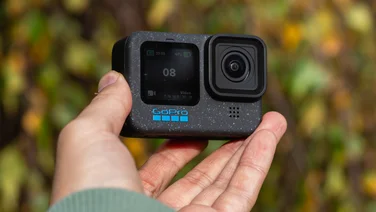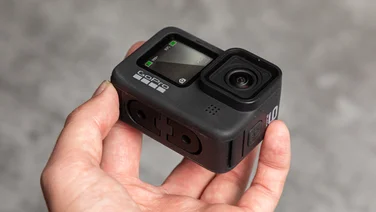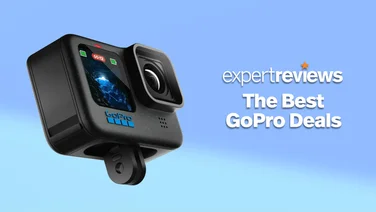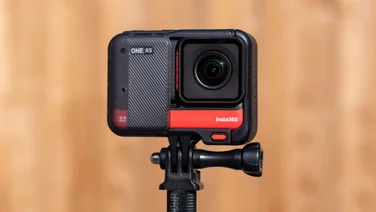To help us provide you with free impartial advice, we may earn a commission if you buy through links on our site. Learn more









- Great image quality and stabilisation
- Easy to use
- Backwards-compatible with One R and RS Cores
- Heavy
- Expensive
- Only IPX3 water-resistant
The Insta360 One RS 1-inch 360 Edition is one of the most interesting action cameras I’ve ever come across. Not only is it a 360˚ camera, which is enticing in itself, but it’s the first I’ve reviewed to come with 1in sensors behind each of its fisheye lenses and the first developed in partnership with Leica.
It’s also, rather remarkably, modular and backwards-compatible with Insta360’s other modular cameras. That means that if you already own an Insta360 One RS or One R, you can save money by buying just the lens, battery and handle and combining it with your existing Core (the bit with the display).
READ NEXT: Our guide to the best GoPro alternatives
Insta360 One RS 1-inch 360 Edition review: What do you get for the money?
That doesn’t make the 1-inch 360 Edition cheap, however. Whether you buy the bundle in its entirety or as an upgrade for your One R/RS, it’s going to cost you well north of £500. In the case of the full bundle, the price is an eye-watering £810, while the upgrade package is £660. So is it worth it?
If you’re a casual action camera or 360 camera user then the answer is probably no, because there are plenty of other options in the 360 camera space that cost significantly less.
The Insta360 One RS Twin Edition, for instance, gives you double the cameras – a 360 and a regular 4K lens mod – for £500, while the firm’s One X2, a dedicated 360 camera, costs £430. The ageing GoPro Max, meanwhile, costs £480 or a very tempting £380 when bought with a one-year GoPro subscription.
Nevertheless, there are plenty of reasons you might want to go for the One RS 1-inch 360 Edition instead of the options above. The first is video quality: the RS 1-inch Edition offers better image quality and superior stabilisation in low light (see below for details), and that’s largely thanks to the larger 1in sensors behind the f/2.2 lenses.









The second is greater flexibility for 360-degree photography. Capable of shooting 21MP stills, the 1-inch 360 Edition can capture more detail than most rivals and has the potential to create multi-bracketed HDR shots to maximise dynamic range.
Third is that the audio connectivity options have been improved, which should further boost the appeal of the 1-inch 360 Edition for vloggers. Not only can you record audio with the built-in microphones but you can also attach external microphones via the new (optional) bracket and 3.5mm mic adapter. The adapter can be used with any accessory microphone but if you pair it with a RØDE Wireless GO or GO II the camera is able to hide the mic entirely thanks to the way it stitches its 360 images together.









Aside from these upgrades, the rest of the specifications are impressive but not game-changing. The camera captures 360 video at up to 6K (5,888 x 2,944) 30fps at a bit rate of up to 120Mbits/sec, so not a huge bump from the 5.7K of the One X2. Footage can also be exported as a “reframed” flat 1080p video for sharing or displaying where 360 playback isn’t practical. 360-degree photographs, meanwhile, are captured at 21MP (6,528 x 3,264), either in .dng RAW or JPG.
As with other Insta360 cameras, the 1-inch 360 Edition comes with the firm’s superb FlowState image stabilisation along with full 360-degree horizon levelling, which means your video footage remains stable and dead level, no matter how you orientate the camera.
The resulting video and stills can then be edited either on your phone via the iOS or Android app, via the Insta360 Studio desktop app (available for both macOS and Windows) or by using plugins for Final Cut Pro X or Adobe Premiere.
READ NEXT: Our guide to the best GoPro alternatives
Insta360 One RS 1-inch 360 Edition review: What does it do well?
Insta360’s excellent modular system works as well here as it does with the regular Insta360 One RS, but the way it all comes together is subtly different. Instead of the lens, Core and battery modules simply clipping together, the 1-inch 360 Edition features an all-new handle. The battery and Core slide into the handle first and then the lens module clips on top to hold everything in place.
It all feels perfectly solid and it’s relatively easy to take apart and replace the battery if you need to. I prefer the hinged flap covering the microSD and USB-C port to the tethered flaps on the One X2 and One RS as well; it’s much easier to close and there’s less fiddling around to clear the USB port for charging.









Both image quality and video stabilisation are superb. Although there’s still visible noise when you get into low-light situations, the camera performance is noticeably better than the Insta360 One X2 with its smaller 2/3in sensors. There’s less overall noise in the images and things look smoother when the light dips. You can see this in action in the clip below at 2:58, when I ride below the bridge.
The image stabilisation and horizon levelling work superbly, as it always seems to do with Insta360’s 360 cameras. The clips above and below were filmed with both the One X2 and the One RS 1-inch 360 Edition cameras attached to the handlebars of my carbon-fibre gravel bike, and both cameras were wobbling around like crazy on the canal towpath’s rough surface. That you can barely tell until you look at the One X2 footage to see exactly how much it is oscillating is a testament to just how effective FlowState on this camera is.
The other thing that’s great about Insta360’s 360 cameras is how easy the footage is to edit on your phone once you’ve captured it. This hasn’t always been the case, but the app has been updated and refined to the point where you can put together quick reframed edits based on your 360 footage and upload them to YouTube within minutes of capture.
Adding keyframes to change the camera’s viewpoint from position A to position B in the frame is child’s play and the Deep Track feature, which lets you draw a box around objects or people and have the camera follow them automatically, saves huge amounts of editing time.
In addition to the simple reframing of clips, the app lets you add music, edit multiple clips together using the Story feature, and there’s also fun to be had in the ShotLab section where you’re guided in the creation of all manner of weird and wonderful effects, such as “Cinelapse” and “Clone trail”. Naturally, clips can also be sped up and slowed down, the field of view can be changed and filters added, all quickly and easily.
Insta360 One RS 1-inch 360 Edition review: What isn’t so great?
My main gripe with the One RS 1-inch 360 Edition is the size and the weight of the thing. Incorporating larger sensors into a camera inevitably adds bulk (physics, who knew?) and, once fully assembled, it weighs 239g and measures 53 x 50 x 129mm (WDH). That’s too heavy to mount on a helmet comfortably, so your mounting options are going to be restricted to popping it atop one of Insta360’s invisible selfie sticks, a tripod or whatever you’re riding or driving.









Incidentally, the One RS 1-inch 360 uses a 1/4in threaded tripod mount instead of the two-pronged system favoured by GoPro cameras (and the Insta360 One R/RS), so if you have a bunch of GoPro mounts hanging around you won’t be able to use them without an adapter.
Possibly more serious, especially if you’re planning on using the Insta360 One RS to record more extreme activities, is that it’s only IPX3 water-resistant, whereas the InstaOne X2 is waterproof to 10m. That’s quite a difference and means that, although the 1in model will be okay to take out in the rain, you won’t be able to stick it on the end of your surfboard or take it snorkelling.









Other issues are smaller but nonetheless worth pointing out. The tiny touchscreen, for one, remains fiddly to use when out and about. It’s no different to other Insta360 cameras and is a touch more usable than the One X2’s even smaller circular display, but the GoPro Max beats it in this respect.
And, while low-light performance is superior to other 360 cameras I’ve tested, it’s not quite the advance I was hoping for. There’s still noticeable noise when you go inside or when the light drops off, and footage is more prone to stabilisation jitter as well. And if you’re capturing multi-frame HDR images in low light, plan on using a tripod otherwise the alignment may be off.
READ NEXT: Our guide to the best GoPro alternatives
Insta360 One RS 1-inch 360 Edition review: Should you buy one?
While the Insta360 One RS 1-inch 360 Edition is an impressive camera that offers both improved stabilisation and image quality over the firm’s other 360 cameras, a number of issues undermine its appeal. Chief among these are the extra weight and the high price, although the relatively weak IPX3 water resistance isn’t great, either.
If you plan on using the camera mainly on a selfie stick or tripod and you do a lot of 360 stills or live streaming work, then the extra image quality will certainly be of benefit.
Casual users or the action camera crew, however, will be better off sticking with – and saving money on – the regular Insta360 One RS Twin Edition, the GoPro Max or the smaller, lighter Insta360 One X2.






